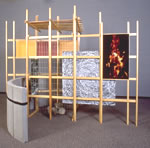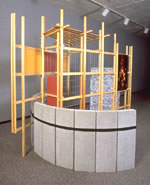


Selecting the Artist
The way in which artists
are identified depends on the nature and scope of the commission. Follow
this link for specifics on various selection processes
and additional considerations.
The Consultation Process
Look at the opportunities to involve the community in consultation; what are the aims behind involving the community? Are they to:
- Involve them directly in the concept and/or design and making of work?
- Create educational workshops linked to the commission?
- Involve them in identifying the artist and/or sites, informing the brief through sourcing ideas for work?
- Give opinions on various designs and be involved in the final decision making process?
- Inform of them of the process and gain informal feedback?
Some form of consultation is always necessary. A commission should not exist as an isolated process, which then suddenly appears on site. The location itself will very much define the sort of consultation required - work within a deparment or college will require a different consultation process compared to work being created for internal and external stakeholder communities. Consultation can:
- Result in wider sense of ownership and understanding of the project
- Create a sense of pride and raise awareness/appreciation of the locality
- Provide opportunities to develop and utilise local skills
- Provide a means by which the community can have control over its environment
The above are by no means definitive lists. They are simply intended to demonstrate the importance of establishing a consultation process.
Contracts
Contracts should always be clearly agreed and issued prior to any work taking place. It is essential that the client and artist have had an opportunity to discuss and agree a mutually acceptable contract. There are various examples of contracts available. One widely used version is produced by AN Publications - Commission Contracts. Briefly, a contract should include the following:
Overall timetable stages
Definition of involved parties, names and addresses
Details of the commission, the design stages and the artist's brief
The responsibilities of the Commissioner/Design Team (eg site preparation, planning consents and approvals)
Delivery of work, installation and insurance requirements including professional indemnity
Warranties and repairs
Fees and methods of payment
Ownership
Risk of loss or damage
Maintenance agreement
Copyright, reproduction rights, credits and moral rights
Relocation
Termination of agreement
Disputes procedure
Role of consultant (if applicable)
Schedule of work
Confirmation of budget (construction budget if applicable) and budget holder (if not the artist).
Managing the Commission Process
It is essential that the commission is overseen and monitored by a steering or management group. This group could comprise members representing the community, the commissioner, funders, arts expertise in the form of an independent public art consultant and/or artist and other interested parties. The group should include the person responsible for the implementation of the commissioning process, who is the link person (key contact) for the artist. Often, this role is undertaken by a public art consultant or lead artist. This role is a pivotal one in that it ensures good communication between all parties and ensures the project runs smoothly, to budget and on schedule. It is also particularly beneficial for artists who do not have much experience of the commissioning process and who therefore need guidance from a specialist source.
Documentation and Evaluation
It is important to build in some sort of documentation and evaluation process. This not only ensures that a detailed record of the project is available for future reference; it also helps promote the project wider afield. Also by comparing the actual chain of events with the planned, it will be easier to undertake an evaluation of the project. By carrying out a full evaluation, the commissioner can demonstrate to all parties involved, including funding partners, the success of the project, learn from the process and plan confidently for future projects.
Celebration
It is important to plan some form of 'unveiling' or inauguration. This not only recognises all the hard work which has gone into the project but provides an opportunity to publicise it and gain, through media publicity, some recognition and feedback on the project.
(This appears with
some minor changes from the following excellent site in the UK:)
http://www.publicartonline.org.uk/index3.htm